Everything You Need to Know About Growing Strawberries in Pots

By Hannah Twietmeyer
From apples and pears to lemons to limes, growing your own fruit is a fun and rewarding way to lower your grocery bill and have the same produce you enjoy fresh on hand. If strawberries are among the crops you want to tackle next growing season, you may want to stock up on some plant containers to make the process a little easier.
Yes—you can actually grow strawberry plants in pots. Whether you already have a garden and want to save some space, or you’re a gardening novice with minimal experience and materials, growing strawberries in or containers is a simple solution. The best part? You’re still left with juicy, decadent red fruit.
Photo via Shutterstock
Types of Strawberries
Strawberries come in two different growing varieties—everbearing and June-bearing. Each plant has its own growing habits, but everbearing strawberries are best for potting. Here’s a little bit about the difference between the two.
Everbearing Strawberry Plants
Also known as day-neutral strawberry plants, the everbearing variety gets its name from its ability to produce fruit all throughout the growing season. This means strawberries grow continuously between the months of July and October, or up until the first frost date (per Chicago Botanic Garden). Since they thrive and produce for one season and then decline—just like other annuals—everbearing strawberry plants are suitable options for potted environments. Simply remove them after the growing season, and plant new ones next spring! Popular varieties of everbearing strawberries include Seascape, Evie-2, and San Andreas.
June-bearing Strawberry Plants
As the name hints, June-bearing strawberry plants typically bear fruit only in the month of June, albeit a large crop. Since they technically classify as perennials, June-bearing strawberry plants will grow to produce a crop once during the growing season, then go dormant after that before returning next year. Popular varieties of June-bearing strawberries include Jewel, Annapolis, and Honeoye (via Espoma).
While the everbearing variety does well in pots, June-bearing strawberry plants do not. They need plenty of room to grow and spread, so they are better off planted in-ground or in a large raised garden bed.
Reasons for Growing Strawberries in Pots
Gardeners who decide to grow their strawberry plants in pots versus the ground do so for a variety of reasons. Sometimes, it’s just preference, but there are several things you’ll want to consider before making a decision on a growing location.
You’re Short on Space
Potting your strawberry plants is a practical solution to limited space. Although June-bearing varieties—which shouldn’t be planted in containers anyway—take up a lot of space when growing, using pots to hold even the smaller everbearing strawberry plants can leave room in your garden for other crops. And if you want to start growing strawberries but don’t have a garden, you can opt for pots as long as you still have access to plenty of sunlight and water.
Upkeep is Easier
Although your potted strawberry plants will still require care and support, it’s likely going to be less than their in-ground counterparts. Like other crops that grow in an outdoor garden, especially ones that spread and sprawl over the ground, strawberries are at risk for pests and disease. While potting your strawberry plants won’t completely eliminate these issues, it does limit certain risk factors that could harm your plant, resulting in lower maintenance for the gardener.
Aesthetic
They’re not necessarily a priority to crop farmers, but potted plants make all the difference when it comes to home decor. As long as you have the right container—which we will discuss below—and give your plants some TLC, strawberries can cascade over hanging baskets and window boxes to brighten up your porch or patio.
Photo via APieceofRainbow
Choosing a Container for Strawberries
You may have some old terra cotta pots lying around the garage or garden shed that could potentially be new homes for your strawberry plants, but not all containers work. Keep the following points in mind before you start sowing seeds:
- Strawberries need space. It’s tempting to try and cram as many plants as possible into a pot for some lush greenery, but you’re already saving on space by using a pot, so take it easy. Strawberries, like many other plants, need their space and don’t do well in cramped settings. If you already have pots at home, take their size into account. For round containers, you should generally plant no more than three to four strawberry plants per 12-inch diameter, spread even widths apart. For long containers, such as window box planters, try to keep your plants at least eight inches apart, and look for containers with a depth somewhere between 10 to 18-inches (via Oregon State University).
- Drainage is a must. Strawberries don’t like soggy soil and require excellent drainage. Most potting containers have drainage holes on the bottom, which is a good start. However, if you’re able to find containers with drainage holes lining the sides as well, this is ideal. It may look like your soil will dislodge through the holes, but trust us—always opt for better drainage if you can. Mr. Stacky 5-Tier Strawberry Planter Pot, $36, Amazon
How to Grow Strawberries in Pots
You’re almost ready to get started! Before you head to your nearest nursery, it’s important to gather all the materials you need to pot your strawberries successfully.
Tools and Materials:
- Strawberry seeds
- Potting soil
- Potting container
- Gardening gloves
- Spade
- Watering can or similar watering device
Step 1: Select the Right Seeds
As we discussed in the “Types of Strawberries” section above, everbearing or day-neutral strawberry plants are good varieties to grow in containers. Do not select June-bearing strawberry plants for pots, as they often grow much larger and therefore do better in-ground. You should be able to locate the correct seeds at a local nursery or hardware store. They’re often sold in packets of 15 or 25 seeds. Proven Winners 15-Count Seeds Berried Treasure Pink - Strawberry (Fragaria) Pink Flowers and Red Strawberries, $8, The Home Depot
Step 2: Select the Proper Potting Soil
Strawberry plants do best in well-draining conditions. They like water, but not sitting in it for extended periods of time—that poses the risk of root rot. So, a potting soil that has excellent draining properties is a must. Strawberries specifically do well in loamy soil, or soil that has roughly equal amounts of clay, sand, silt, and organic matter. Always be sure to test your soil pH as well to make sure things are not too acidic or alkaline—strawberries require a pH between 5.6 and 6.5 (per Oregon State University). Ocean Forest 40 lbs. 6.3-6.8 pH Plant Garden Potting Soil Mix, $30, The Home Depot
Step 3: Plant Your Seeds or Seedlings
Using a small spade or gloved hands, transfer your potting soil into a container of choice. Fill it to the top with soil, and sow your seeds near the surface, giving the roots plenty of space to grow downward. If you happen to be using seedlings, plant them just far enough in the soil so that the crown of growth sits above the surface. Remember—give your seeds some room. Plant them about eight to 10-centimeters apart from each other.
Step 4: Provide Water and Sunlight
Place your potted strawberry plants in an area that gets between six and 10 hours of direct sunlight every day—sun is a necessity for big, bright fruits. Water the seeds as soon as they are planted.
With the proper materials, some time, and TLC, you’ll have an abundance of strawberries in no time!
Photo via BrownThumbMama
How to Care for Potted Strawberries
The growing process—although straightforward—takes plenty of time, so understanding the best way to care for your strawberries between planting and harvesting is important. Take note of the following during your strawberry plants’ growth cycle:
- Check soil moisture often. As noted in the instructions above, strawberry plants usually require between 1 and 1.5 inches of water per week. If you aren’t sure about the state of your plant’s hydration, stick your index finger into the soil. If it’s dry about half an inch down, it could use some water—the soil should be moist, but never soggy or holding stagnant water (via Pennington).
- Don’t skip the fertilizer. If the potting soil you have doesn’t have adequate fertilizer mixed into the soil, you’ll have to supplement your plants with some. Strawberries in particular need a good amount of nitrogen to thrive, so look for a supplement with reliable nitrogen content. Espoma Organic Berry-tone Organic Granules Plant Food 4 lb, $10, Ace Hardware
- Pinch and prune. As your plant starts to establish and grow, you’ll begin to notice flowers. They’re pretty, but during the first two weeks of flowering, you’ll want to pinch them off, as they suck energy from the roots and can stunt fruit production. After those two weeks, you can let them grow. Prune runners, or the vining stems that grow far beyond the pot, as necessary. Everbearing strawberry plants don’t produce too many runners, but if they start to get out of hand, just give them a trim with your hand pruners.
- Know the right time to harvest. The fruits will typically be ready to harvest four to six weeks after the plants start to blossom. You’ll know they’re ready for picking when they’re fully red (how they would look in the produce aisle at the grocery store). To harvest, cut the stem right above the leafy green crown at the top of each strawberry. Avoid pulling the berry directly off the vine, which can damage the plant.
Have you successfully grown strawberries in containers? We’d love to know how—leave a comment below!



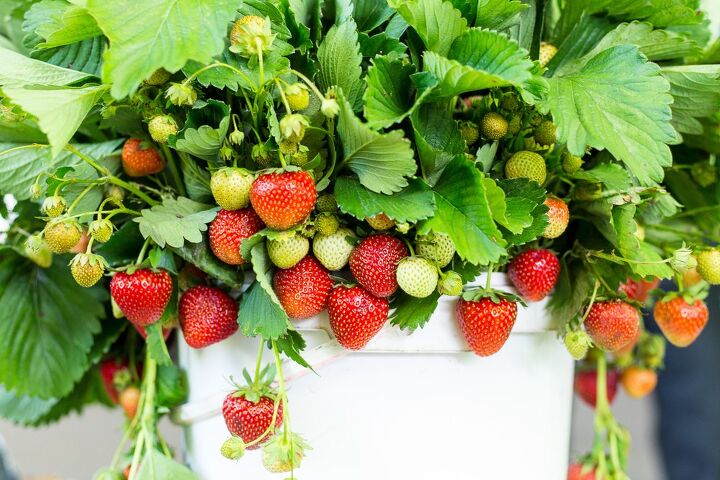







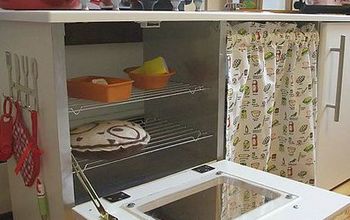

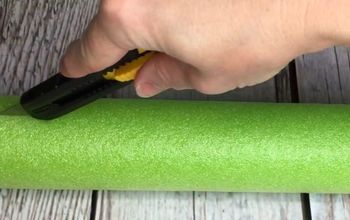

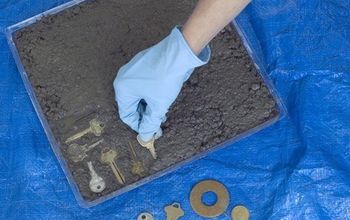

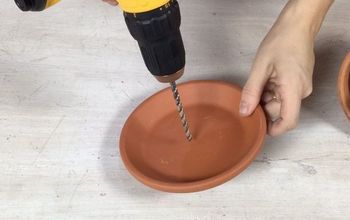





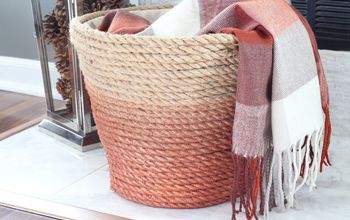
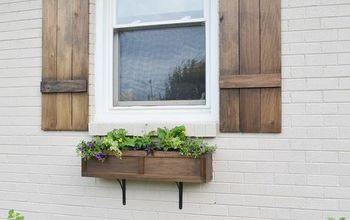

Frequently asked questions
Have a question about this project?
Live in So. Missouri, zone 6b. What about winter storage? WANT to do this alot!